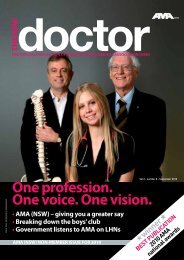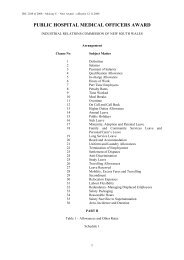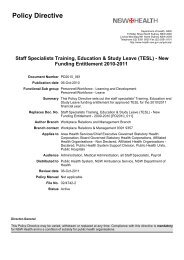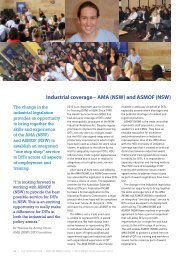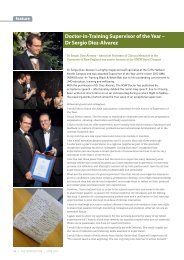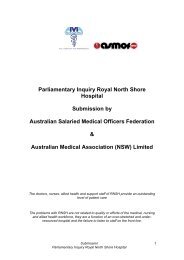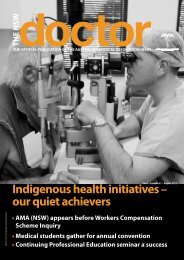The people behind the policies... - Australian Medical Association ...
The people behind the policies... - Australian Medical Association ...
The people behind the policies... - Australian Medical Association ...
You also want an ePaper? Increase the reach of your titles
YUMPU automatically turns print PDFs into web optimized ePapers that Google loves.
home care in Australiachild or young person’s physical,developmental and psychosocialand mental health needs are to beidentified in a preliminary healthcheck. This will provide advice on <strong>the</strong>specialist services required and <strong>the</strong>timing of a comprehensive health anddevelopmental assessment. Childrenand young <strong>people</strong> are to have <strong>the</strong>ir ownwritten health record which moves with<strong>the</strong>m if <strong>the</strong>y change placements.Effective implementation of thisnew National Standard will go someconsiderable way to ensuring that <strong>the</strong>health needs of children in out-of-homecare are met in a more consistent way,leading to more positive outcomes.This will require substantial effortand commitment on <strong>the</strong> part of stategovernments – both communityservices and health portfolios and <strong>the</strong>many non-government organisationsthat provide out-of-home care services.Children in out-of-home care are partof our community and experience pooroutcomes through no fault of <strong>the</strong>ir own.It is incumbent on all of us to work toensure that <strong>the</strong>y have a better chanceto grow up safe and well.Life Without Barriers is <strong>the</strong> largest nongovernmentprovider of out-of-home careacross Australia1 Nathanson, D., & Tzioumi, D. (2007). Health needs of<strong>Australian</strong> children living in out-of-home care. Journal ofPaediatrics and Child Health, 43, 695-699.2 http://www.fahcsia.gov.au/sa/families/pubs/nat_std_4_outofhomecare/Pages/default.aspx3 http://www.fahcsia.gov.au/sa/families/pubs/kpmg_final_report_nsfohc/Pages/default.aspx4 Report on Government Services 2010 http://www.pc.gov.au/__data/assets/pdf_file/0006/93966/61-chapter15.pdfp 15.125 Report on Government Services 2010 http://www.pc.gov.au/__data/assets/pdf_file/0006/93966/61-chapter15.pdfTable 15A.166 http://www.community.nsw.gov.au/docswr/_assets/main/documents/bcg_report.pdf p A. 60.7 Harden, B. (2004) Safety and Stability for Foster Children:A Developmental Perspective in Children, Families andFoster Care Vol.14, No.1, p 39.8 Nor<strong>the</strong>rn California Training Academy (2008) PlacementStability in Child Welfare Services: Issues, Concerns,Outcomes and Future Directions Literature Review. p 4.9 http://www.lboro.ac.uk/research/ccfr/Publications/placementstabilitylitreview.pdf p.2.10 Report on Government Services 2010 http://www.pc.gov.au/__data/assets/pdf_file/0006/93966/61-chapter15.pdfTable 15A.2411 Life Without Barriers 2008/09 data for NSW OOHCservices12 http://www.create.org.au/news-and-events/kids-in-carewithout-a-road-mapOut-of-home in Australia<strong>The</strong>re are about 34 000 children in out-of-home care in Australia, including15,211 in NSW 4 . <strong>The</strong> rate of children in out-of-home care Australia-wide is6.7 per 1,000 children. This rate is 44.8 per 1,000 for indigenous children, and4.9 per 1,000 for non-indigenous children.<strong>The</strong> rate for children in out-of-home care in NSW is 9.4 per 1,000 children(71.3 indigenous; 6.6 non-indigenous). Victoria is 4.3 per 1,000 children (48.7indigenous; 3.8 non-indigenous), Queensland 6.7 per 1,000 children (36.0indigenous; 4.6 non-indigenous) and Western Australia 5.1 per 1,000 children(38.8 indigenous; 3 non-indigenous). 5In NSW, Community Services directly provides out-of-home care forapproximately 85 per cent of children in out-of-home care with <strong>the</strong> remaindercared for by non-government agencies. Non-government agencies haveresponsibility for 84 per cent of high needs children. 6Placement stability for children in out-of-home care is often used as aproxy indicator of quality. 7,8,9 In NSW, 43.5 per cent of children in out-of-homecare have moved three or more times per year. 10 Australia-wide this statisticis 50.3 per cent. For non-government agency Life Without Barriers in NSW,<strong>the</strong> proportion of children moved three or more times per year is 2.3 percent 11 ). <strong>The</strong> higher <strong>the</strong> number of moves <strong>the</strong> greater <strong>the</strong> impact on schooling,healthcare and social networks.Outcomes for children in out-of-home care are very poor. A survey by <strong>the</strong>CREATE Foundation found that:“<strong>The</strong>y are at higher risk of developing recognised characteristics ofyouth who have left care such as being more likely to be undereducated,unemployed, to earn less, become a parent at a younger age, be involvedin <strong>the</strong> juvenile justice system, become homeless, be dependent on socialassistance, have mental health issues, attempt suicide and be at a higher riskof substance abuse”.<strong>The</strong> CREATE report noted that:n 64 per cent of young <strong>people</strong> do not have a leaving care plan (a strategy forlife after being in <strong>the</strong> care system).n 35 per cent of young <strong>people</strong> in out-of-home care are homeless in <strong>the</strong> firstyear after leaving care.n 46 per cent of boys in out-of-home care are involved in <strong>the</strong> juvenile justicesystem.n 35 per cent of young <strong>people</strong> in out-of-home care completed Year 12.n 29 per cent are unemployed (compared to <strong>the</strong> national average of9.7 per cent).n 28 per cent were already parents <strong>the</strong>mselves. 12 www.amansw.com.au I 17





